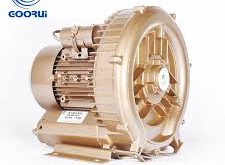Single-Stage and Dual-Stage Regenerative Blowers
Operating Principles: The impeller rotates inside the blower housing, pulling air in through the inlet, or vacuum side. The impeller then accelerates the air or gas inside the housing until it is fully pressurized, and discharges it through the exhaust outlet, or pressure side.
Single-stage blowers are the most common type of regenerative blower; with these blowers, air travels around the internal air channel once and is then exhausted out to the application. Dual-stage regenerative blowers can provide a lot more pressure or vacuum than their single-stage counterparts because the airflow is channeled back around the impeller for a second rotation before being exhausted. This causes the air to be more laminar which greatly increases the velocity pressure of the conveyed air.
What about maintenance? The motor shaft is the only moving part, which spins the impeller directly; it does not come in contact with the housing at all and is, therefore, “wear-free”. Pre-lubricated bearings are the only wearing parts, and these days, bearings have some of the lowest failure rates of any mechanical item in existence.
 وکیوم آبی و بلوئر هوا فروش و تعمیر انواع وکیوم آبی و بلوئر هوا
وکیوم آبی و بلوئر هوا فروش و تعمیر انواع وکیوم آبی و بلوئر هوا

